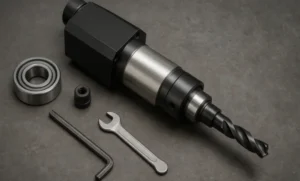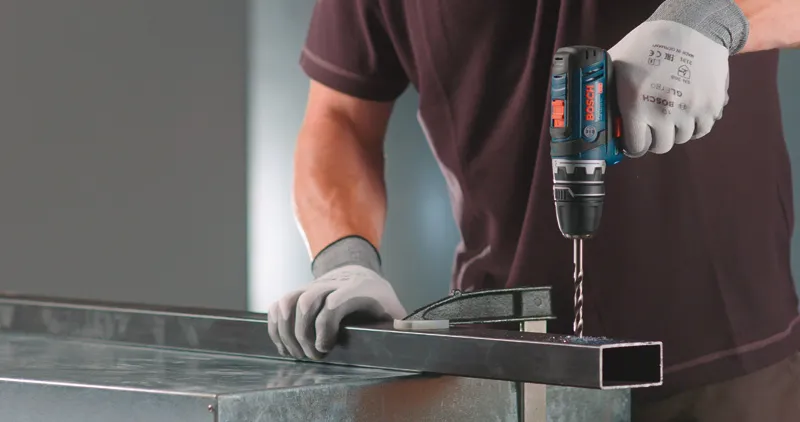What is a Winkelbohrspindel?
A Winkelbohrspindel, often referred to as an angular drilling spindle, is a specialized tool used primarily in machining processes to enhance precision during drilling operations. This component is designed to facilitate angled drilling, allowing for a wide range of applications within the manufacturing industry. The Winkelbohrspindel’s fundamental purpose is to provide a precise angle for the drill bit, ensuring that the resultant holes meet exact specifications required in various engineered parts.
The design of the Winkelbohrspindel comprises several essential components that work together to achieve its designed purpose. These typically include the spindle itself, a gear mechanism to adjust drill angles, and a robust housing to support the entire assembly. The spindle can rotate at various speeds and is often manufactured from high-strength materials to withstand the rigors of consistent machining operations. Additionally, precision bearings are integral to the design, minimizing friction and maximizing performance.
One of the key features of the Winkelbohrspindel is its ability to maintain accuracy across multiple drilling angles. This capability is achieved through advanced engineering technology, allowing for smooth transitions between different positions without compromising the quality of the drilled holes. The level of precision that a Winkelbohrspindel can provide is crucial, particularly in industries where tolerances are tight, and the integrity of component parts is paramount.
In summary, the Winkelbohrspindel is a critical invention in modern machining that enhances drilling precision significantly. By understanding its components, design features, and purpose, one can appreciate how it plays a vital role in manufacturing, ensuring that products meet specific quality standards required across various sectors.
Applications of Winkelbohrspindel in Industries
The winkelbohrspindel, with its exceptional performance in precision drilling, has become a crucial tool in various industries. One of the most prominent sectors benefiting from its capabilities is the automotive industry. Here, the need for highly precise drilling processes is paramount due to the intricate designs of modern vehicles. The winkelbohrspindel excels in this environment, enabling the formation of complex geometries and ensuring high-quality assemblies with reduced error margins. Automotive manufacturers demand high throughput, and the efficient operation provided by the winkelbohrspindel significantly enhances productivity while maintaining accuracy.
Similarly, in the aerospace sector, the requirements for drilling are even more stringent. Components often need to endure extreme conditions, which necessitates flawless manufacturing standards. The winkelbohrspindel allows aerospace engineers to achieve the intricate tolerances required in avionics and structural components, fundamentally making it integral to this industry’s supply chain. With the capacity to drill lightweight materials such as titanium and composites, the winkelbohrspindel ensures weight efficiency, crucial for aircraft performance and fuel economy.
Another vital application of the winkelbohrspindel is in the medical manufacturing sector. Here, the precision drilling required for producing implants and surgical instruments is critical for patient safety and device efficacy. The winkelbohrspindel’s capability to handle advanced materials and produce consistent results makes it an invaluable tool in the medical field. Real-world examples, such as its use in creating orthopedic implants and precision tooling for minimally invasive procedures, underline its versatility and effectiveness across different applications.
Overall, the winkelbohrspindel meets diverse drilling requirements across these industries, showcasing its adaptability and essential role in modern machining practices. From automotive to aerospace and medical manufacturing, its effective implementation demonstrates how technology can enhance precision and efficiency in production processes.

Advantages of Using Winkelbohrspindel
The implementation of Winkelbohrspindel in modern manufacturing processes presents a multitude of advantages that significantly enhance operational efficiency and precision. One of the primary benefits is the remarkable increase in accuracy during machining. The design of the Winkelbohrspindel facilitates a precise orientation of the drilling tool, enabling manufacturers to achieve tighter tolerances and superior surface finishes. This level of precision is crucial in industries where minute details can drastically impact the final product’s quality.
In addition to improved accuracy, utilizing a Winkelbohrspindel promotes enhanced efficiency in production workflows. The spindle’s design allows for higher speeds and reduced cycle times, which ultimately translates to increased output. By minimizing the time taken for each machining operation, manufacturers can significantly boost their production capacity, enabling them to meet the growing demands of the market without compromising quality.
Furthermore, the use of Winkelbohrspindel is associated with reduced material wastage. The precision of the drilling process ensures that materials are utilized effectively, minimizing the instances of errors that often lead to scrap and discards. As manufacturers strive for sustainability and cost-effectiveness, employing tools that optimize material use becomes increasingly important.
Cost savings emerge as another pivotal advantage of integrating Winkelbohrspindel into machining practices. By enhancing operational efficiency, manufacturers can lower their overhead costs while simultaneously increasing their profit margins. The combination of reduced cycle times, minimized material wastage, and improved accuracy culminates in financial benefits that make the Winkelbohrspindel a prudent investment for businesses aiming to enhance their machining capabilities.
Ultimately, the advantages of increased accuracy, efficiency, and cost savings position the Winkelbohrspindel as a valuable asset in modern machining, guiding manufacturers toward achieving their production goals more effectively.
Future Trends and Innovations in Winkelbohrspindel Technology
As industries evolve, so does the technology that drives precision machining systems such as the winkelbohrspindel. The future of winkelbohrspindel technology is poised for substantial advancements, particularly in several key areas including materials science, automation, and the integration of smart manufacturing systems. These innovations will not only enhance the functionality of the devices but also ensure they meet the growing demands of efficiency and sustainability within the manufacturing sector.
One of the most crucial areas of development is the use of advanced materials to improve the performance and longevity of winkelbohrspindels. New lightweight, high-strength materials such as carbon fiber composites and advanced alloys can increase the operational speeds and reduce wear in high-load applications. This shift towards utilizing innovative materials can lead to a decrease in maintenance costs and longer service intervals, therefore maximizing productivity.
Automation is another key trend shaping the future of winkelbohrspindel technology. As companies strive for more streamlined processes, integrating advanced robotic systems and automated setups is becoming increasingly common. The incorporation of robotics not only enhances precision but also allows for increased adaptability to various machining tasks. This is particularly significant in environments where speed and accuracy are paramount.
Moreover, the rise of smart manufacturing systems emphasizes the need for devices like winkelbohrspindels to be compatible with Industry 4.0 technologies. The integration of the Internet of Things (IoT), big data analytics, and machine learning into the production process is revolutionizing how products are manufactured. Future winkelbohrspindel designs are likely to feature smart sensors that provide real-time data, enabling predictive maintenance and ultimately leading to reduced downtime in manufacturing operations.
Looking ahead, we can anticipate that these trends and advancements will reshape the winkelbohrspindel landscape significantly over the next decade, reinforcing its essential role in modern machining processes and helping manufacturers achieve new levels of precision and efficiency.
